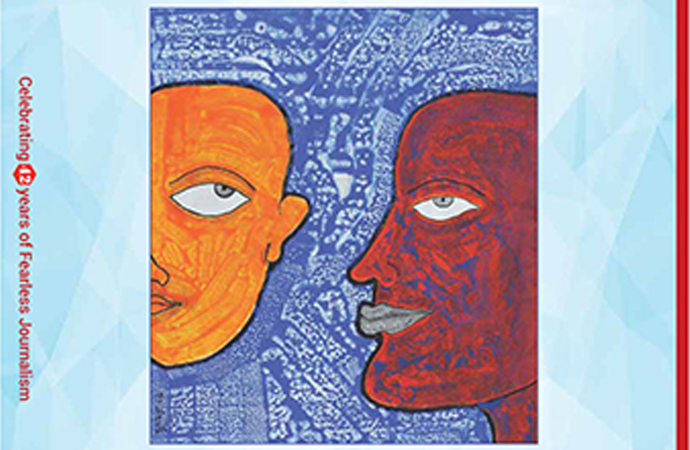Featured 2

Today, we live in a globalised and interconnected world with rapid technological advancement in place. And the digital technologies that we have around us have invited a host of prickly and troubling ethical challenges for everybody across the world, not just for working journalists and media practitioners. In this digital age, with enormous benefits on count, everybody is also facing some challenges no matter whether you are a professional, a citizen or even a government employee.
When this is the situation at home and beyond the boundary today, a new book titled 'Art Against Fake News' published by Cosmos Books hit the market giving some answers to the problem and helping policymakers and stakeholders to give a serious look at the issue with some deep thoughts.
Enayetullah Khan, a truly global citizen and founder of Cosmos Group, has taken very timely decision to come up with such an important book when everybody is looking for ways to deal with the fake news effectively and make sure that there is no online hate or fake news around us.
The book contains very rich contents written by Law, Justice and Parliamentary Affairs Minister Anisul Huq, French lawyer and author of the report to Unesco on online radicalization and expert with the Council of Europe on the Internet Ombudsman Dan Shefet, Cosmos Foundation President and Principal Research Fellow at the Institute of South Asian Studies (ISAS) at the National University of Singapore Dr Iftekhar Ahmed Chowdhury, Professor of Law and Economics at the National School of Administration and of Information and Communications Law at the Luiss Guido Carli University of Rome Maurizio Mensi, Director for the European Schools in Oxford Tom Hoyem, and prominent artist and cartoonist Rafiqun Nabi and Enayetullah Khan himself, an author of a number of books.
Enayetullah Khan, a renaissance man with diverse interests and successful media entrepreneur, very lucidly and elaborately talked about online hate, fake news and hate speech; its causes and consequences and described how it subverts democratic systems.
The Law Minister highlighted the old problem and the new techniques that are being applied in spreading the fake news. It is true that news and fake news have existed in parallel right from the birth of the country like true and false. Anti-liberation forces had spread fake news during our War of Liberation and afterwards.
Huq recalled the vandalism that the nation saw at a Buddhist village in Ramu of Cox's Bazar in 2012. The vandalism was sparked off just with the spread of fake news and hate speech on social media what we call an unedited platform.
Dan Shefet elaborated on relations between art and fake news saying art speaks the truth and his thoughts on the issue are something interesting that the readers would love to read with much interest.
Dr Iftekhar brought some challenges associated with fake news and hate speech into focus with the aim of shedding light on solutions. He also shed light on some challenges in taking action against fake news and hate speech.
The articles written by Mensi titled 'Art and Truth' and 'This is not a pipe' by Tom Hoyem will help readers think about the issue in a very different way.
I find most of the artists talk less but never hesitate to give the required message to the society in a very stronger way. That's what artist Rafiqun Nabi did. On the page number 77 of the book, the readers will find a tiny piece by the artist, well-known as Ranabi, which gives the readers a very refreshing take.
The cartoon, Ranabi says, is the best way to speak up against fake news. And the book in its cover both on front and back, contains some cartoons similar to paintings that speak a lot. Jean-Jaques Neuer, specialized in Art law, deserves big thanks for writing an excellent headfirst for the book.
We have seen the recent violence in Bhola's Borhanuddin upazila that led to the deaths of four people and injuries many others. The incident due to a fictitious hate speech caused unrest in other upazilas of Bhola. Unfortunately, it had spread to Chattogram, where Hefazat activists brought out protests.
So it is clear that the prevalence of online hate poses challenges to everyone, first and foremost the marginalised individuals who are its principal targets.
Today, most of us start our day with checking the headlines online or the printed newspapers. As the internet penetration is growing across the country, stakeholders in the media, policymakers and relevant bodies need to think afresh to reinforce legal standards to combat online hate and fake news. This book can show the path in that direction and I must say this is a must read book for everyone including media people, journalism students and policymakers.

























Leave a Comment
Recent Posts
The forensic clean up of the f ...
Much of the coverage centring the surge in Non Performing Loans (NPLs) ...
Hong Kong’s deadliest fire in ...
Hong Kong’s deadliest fire in decades left at least 44 people de ...
False document submission hurts genuine students’ ch ..
The Missing Ingredients for Peace in Palestine
Songs of Hyacinth Boats & Hands: Reading Conversatio ..
Executive Editor Julie Pace on why AP is standing fo ..